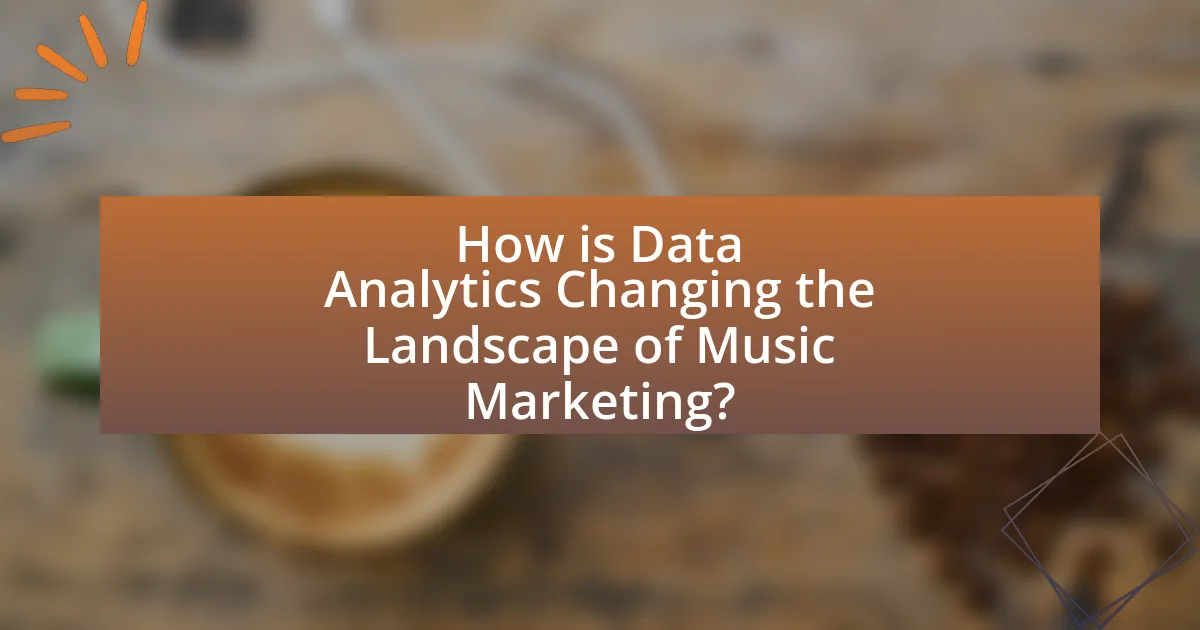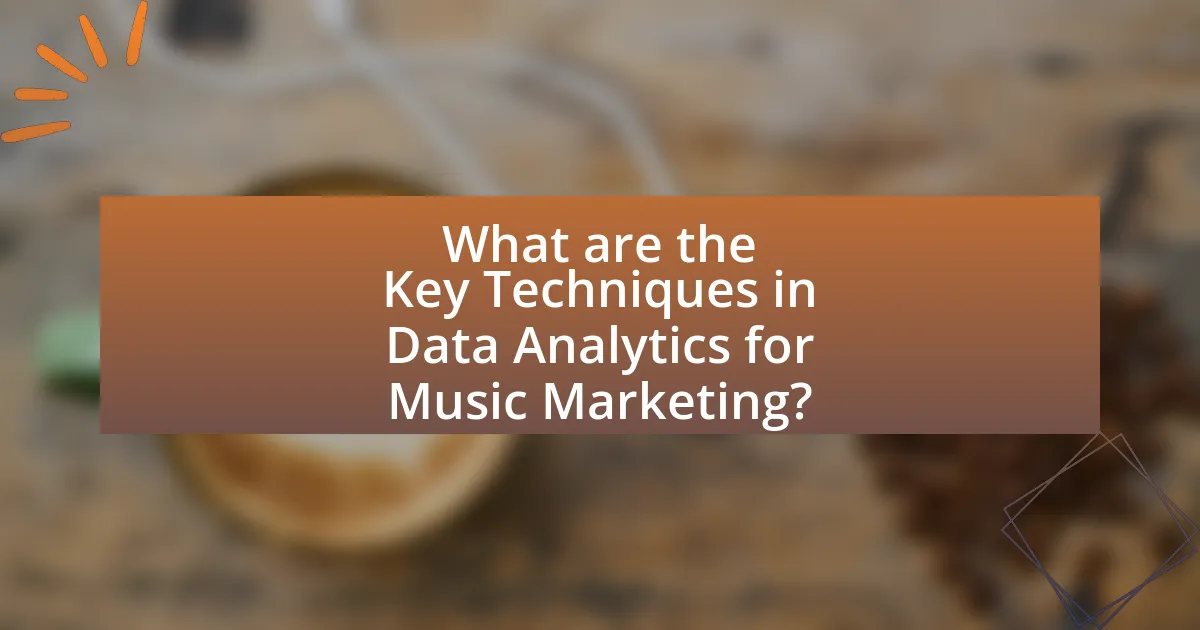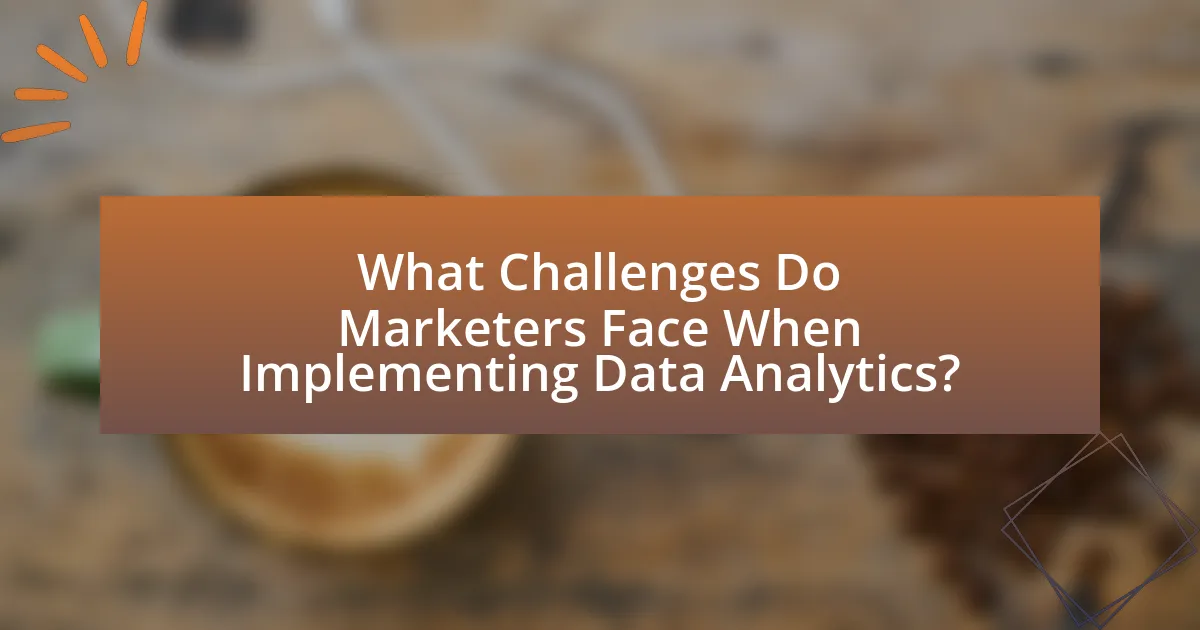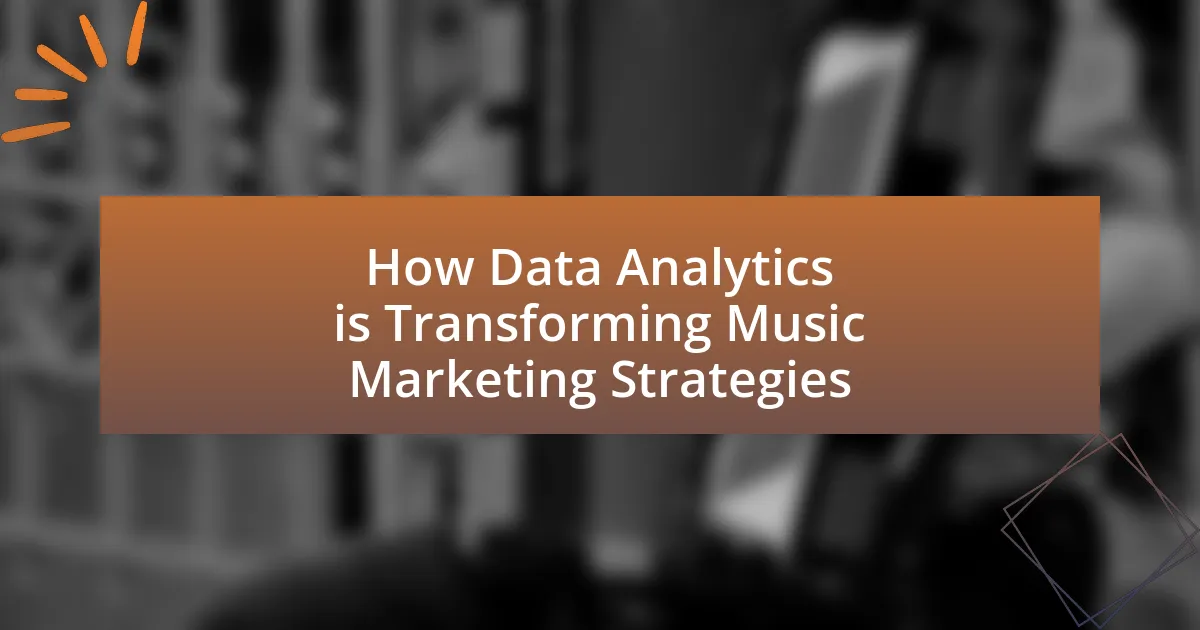Data analytics is revolutionizing music marketing strategies by enabling targeted approaches based on consumer behavior and preferences. By leveraging insights from streaming data, social media interactions, and demographic information, music marketers can tailor campaigns to specific audiences, enhancing engagement and maximizing return on investment. Key techniques such as audience segmentation, predictive analytics, and social media analysis are essential for optimizing marketing efforts. Additionally, the integration of advanced technologies like artificial intelligence is shaping future trends in the industry, emphasizing the importance of data-driven decision-making for artists and labels.

How is Data Analytics Changing the Landscape of Music Marketing?
Data analytics is fundamentally transforming music marketing by enabling targeted strategies based on consumer behavior and preferences. By analyzing streaming data, social media interactions, and demographic information, music marketers can identify trends and tailor campaigns to specific audiences. For instance, platforms like Spotify and Apple Music provide insights into listener habits, allowing artists and labels to optimize release strategies and promotional efforts. According to a report by Nielsen Music, 75% of music marketers now utilize data analytics to inform their decisions, demonstrating its critical role in enhancing engagement and maximizing reach.
What role does data analytics play in music marketing strategies?
Data analytics plays a crucial role in music marketing strategies by enabling artists and labels to understand audience preferences and behaviors. By analyzing streaming data, social media interactions, and demographic information, music marketers can tailor their campaigns to target specific listener segments effectively. For instance, a study by Nielsen Music found that 70% of consumers are more likely to engage with personalized content, demonstrating the effectiveness of data-driven marketing approaches. Additionally, platforms like Spotify and Apple Music provide insights into listener habits, allowing marketers to optimize release strategies and promotional efforts based on real-time data. This targeted approach not only enhances engagement but also maximizes return on investment in marketing initiatives.
How do artists and labels utilize data analytics for decision-making?
Artists and labels utilize data analytics for decision-making by analyzing streaming metrics, audience demographics, and social media engagement to inform marketing strategies and optimize content release. For instance, platforms like Spotify and Apple Music provide detailed analytics on listener behavior, allowing artists to identify their most engaged fan bases and tailor promotional efforts accordingly. Additionally, data on social media interactions helps labels understand which marketing campaigns resonate with audiences, leading to more effective targeting and resource allocation. This data-driven approach has been shown to increase engagement rates and drive sales, as evidenced by a 2021 report from the International Federation of the Phonographic Industry, which highlighted that labels leveraging analytics saw a 30% increase in successful campaign outcomes compared to those that did not.
What types of data are most valuable in music marketing?
The most valuable types of data in music marketing include audience demographics, streaming analytics, social media engagement metrics, and sales data. Audience demographics provide insights into the age, gender, and location of listeners, enabling targeted marketing strategies. Streaming analytics reveal listening habits, such as play counts and skip rates, which help identify popular tracks and optimize playlists. Social media engagement metrics, including likes, shares, and comments, indicate fan interaction and brand loyalty, guiding promotional efforts. Sales data, encompassing digital downloads and merchandise purchases, offers a clear picture of revenue generation and consumer preferences. Collectively, these data types empower music marketers to make informed decisions and tailor their strategies effectively.
Why is data-driven marketing essential for the music industry?
Data-driven marketing is essential for the music industry because it enables artists and labels to make informed decisions based on consumer behavior and preferences. By analyzing data from streaming platforms, social media, and sales, the music industry can identify trends, target specific audiences, and optimize marketing strategies. For instance, a report by Nielsen Music indicates that 75% of music listeners are influenced by personalized recommendations, highlighting the importance of data in reaching potential fans effectively. This targeted approach not only enhances engagement but also maximizes revenue opportunities through tailored promotions and content delivery.
How does data analytics enhance audience targeting?
Data analytics enhances audience targeting by enabling marketers to identify and segment their audience based on specific behaviors, preferences, and demographics. By analyzing data from various sources, such as streaming platforms and social media, marketers can gain insights into listener habits, allowing for more personalized marketing strategies. For instance, a study by Nielsen Music found that targeted marketing campaigns based on listener data can increase engagement rates by up to 30%. This data-driven approach ensures that marketing efforts are directed towards the most relevant audience, improving the effectiveness of promotional activities in the music industry.
What impact does data analytics have on marketing ROI?
Data analytics significantly enhances marketing ROI by enabling precise targeting and measurement of campaign effectiveness. By analyzing consumer behavior and preferences, marketers can tailor their strategies to specific audiences, leading to higher engagement and conversion rates. For instance, a study by McKinsey found that companies using data-driven marketing strategies can achieve a 15-20% increase in ROI compared to those that do not. This demonstrates that leveraging data analytics not only optimizes marketing efforts but also maximizes financial returns.

What are the Key Techniques in Data Analytics for Music Marketing?
Key techniques in data analytics for music marketing include audience segmentation, predictive analytics, and social media analysis. Audience segmentation allows marketers to categorize listeners based on demographics, preferences, and behaviors, enabling targeted campaigns that resonate with specific groups. Predictive analytics utilizes historical data to forecast future trends and consumer behavior, helping artists and labels make informed decisions about releases and promotions. Social media analysis involves monitoring engagement metrics and sentiment analysis to gauge audience reactions and optimize marketing strategies. These techniques are supported by industry reports indicating that targeted marketing can increase engagement rates by up to 30%, demonstrating their effectiveness in enhancing music marketing efforts.
How do streaming platforms contribute to data analytics in music marketing?
Streaming platforms significantly enhance data analytics in music marketing by providing detailed insights into listener behavior and preferences. These platforms collect vast amounts of data, including user demographics, listening habits, and engagement metrics, which marketers can analyze to tailor their strategies effectively. For instance, Spotify’s Wrapped feature showcases user-specific listening trends, allowing artists and marketers to understand audience preferences and optimize promotional efforts accordingly. Additionally, platforms like Apple Music and YouTube Music offer analytics dashboards that track song performance, enabling targeted marketing campaigns based on real-time data. This data-driven approach leads to more effective marketing strategies, as evidenced by the increased engagement and sales for artists who utilize these insights.
What insights can be gained from streaming data?
Streaming data provides insights into listener behavior, preferences, and trends in real-time. By analyzing metrics such as play counts, skip rates, and user demographics, music marketers can identify which songs resonate with audiences and tailor their promotional strategies accordingly. For instance, a study by Nielsen Music found that songs with higher streaming numbers often correlate with increased sales and concert attendance, demonstrating the predictive power of streaming data in shaping marketing decisions.
How do algorithms influence music recommendations and marketing?
Algorithms significantly influence music recommendations and marketing by analyzing user data to personalize content delivery. Streaming platforms like Spotify and Apple Music utilize algorithms that assess listening habits, preferences, and behaviors to suggest songs and artists tailored to individual users. For instance, Spotify’s Discover Weekly playlist employs collaborative filtering and machine learning techniques to curate a unique selection of tracks for each user based on their listening history and the preferences of similar users. This targeted approach not only enhances user engagement but also drives marketing strategies by enabling artists and labels to reach specific demographics effectively. According to a 2021 report by MIDiA Research, 70% of users discover new music through algorithm-driven recommendations, highlighting the critical role of algorithms in shaping music consumption and marketing efforts.
What are the benefits of social media analytics in music marketing?
Social media analytics in music marketing provides valuable insights that enhance audience engagement and optimize promotional strategies. By analyzing data such as user interactions, demographics, and content performance, music marketers can tailor their campaigns to target specific listener segments effectively. For instance, a study by Nielsen Music found that 70% of music listeners engage with artists on social media, indicating that targeted content can significantly increase fan loyalty and conversion rates. Additionally, social media analytics allows for real-time feedback, enabling marketers to adjust their strategies promptly based on audience reactions and trends. This data-driven approach not only improves marketing efficiency but also maximizes return on investment by focusing resources on the most effective channels and content types.
How can engagement metrics inform marketing strategies?
Engagement metrics can inform marketing strategies by providing insights into audience behavior and preferences. By analyzing metrics such as likes, shares, comments, and time spent on content, marketers can identify which types of content resonate most with their target audience. For instance, a study by HubSpot found that content with higher engagement rates leads to increased brand loyalty and conversion rates. This data allows marketers to tailor their campaigns, optimize content distribution, and allocate resources effectively, ultimately enhancing the overall effectiveness of their marketing strategies in the music industry.
What tools are available for analyzing social media data?
Several tools are available for analyzing social media data, including Hootsuite, Sprout Social, and Brandwatch. Hootsuite provides comprehensive analytics for social media performance, allowing users to track engagement metrics across multiple platforms. Sprout Social offers in-depth reporting features that help businesses understand audience demographics and content performance. Brandwatch specializes in social listening, enabling brands to monitor conversations and sentiment around their products. These tools are widely used in the industry, demonstrating their effectiveness in providing actionable insights for marketing strategies.

What Challenges Do Marketers Face When Implementing Data Analytics?
Marketers face several challenges when implementing data analytics, including data integration, data quality, and skill gaps. Data integration issues arise when marketers struggle to consolidate data from various sources, leading to incomplete insights. According to a survey by Deloitte, 49% of organizations cite data silos as a significant barrier to effective analytics. Data quality is another challenge, as inaccurate or outdated information can skew results; a report from Experian found that 91% of companies believe their data is inaccurate in some way. Lastly, skill gaps in data analytics expertise hinder effective implementation, with a McKinsey report indicating that 40% of companies lack the necessary talent to leverage data analytics effectively.
What are the common pitfalls in data analytics for music marketing?
Common pitfalls in data analytics for music marketing include relying on incomplete data, misinterpreting metrics, and neglecting audience segmentation. Incomplete data can lead to skewed insights, as decisions based on partial information may not accurately reflect audience behavior. Misinterpreting metrics, such as confusing correlation with causation, can result in misguided strategies; for instance, assuming that increased streaming numbers directly correlate with successful marketing efforts without considering other influencing factors. Additionally, neglecting audience segmentation can cause marketers to overlook specific demographics, leading to ineffective targeting and wasted resources. These pitfalls can hinder the effectiveness of marketing campaigns and limit the potential for audience engagement and revenue growth.
How can data privacy concerns affect marketing strategies?
Data privacy concerns can significantly impact marketing strategies by limiting the data available for targeted advertising and customer insights. When consumers are increasingly aware of and concerned about their data privacy, they may opt out of data collection practices, leading to a decrease in the effectiveness of personalized marketing campaigns. For instance, regulations like the General Data Protection Regulation (GDPR) in Europe impose strict guidelines on data usage, compelling marketers to adjust their strategies to comply with legal requirements. This often results in a reliance on aggregated data rather than individual-level insights, which can diminish the precision of targeting efforts and reduce overall marketing effectiveness.
What challenges arise from data interpretation and analysis?
Challenges in data interpretation and analysis include data quality issues, complexity of data integration, and the potential for misinterpretation of results. Data quality issues arise when datasets contain inaccuracies or inconsistencies, which can lead to erroneous conclusions. For instance, a study by Redman (2018) highlights that poor data quality can cost organizations up to 30% of their revenue. Complexity of data integration occurs when combining data from multiple sources, making it difficult to achieve a cohesive understanding. Additionally, misinterpretation of results can happen due to cognitive biases or lack of domain knowledge, which can skew decision-making processes. These challenges underscore the importance of rigorous data management and analytical practices in music marketing strategies.
How can marketers overcome these challenges?
Marketers can overcome challenges in music marketing by leveraging data analytics to gain insights into consumer behavior and preferences. By utilizing advanced analytics tools, marketers can segment their audience more effectively, allowing for targeted campaigns that resonate with specific demographics. For instance, a study by Nielsen Music found that data-driven marketing strategies can increase engagement rates by up to 30%, demonstrating the effectiveness of using analytics to tailor content and promotions. Additionally, real-time data tracking enables marketers to adjust their strategies promptly based on audience response, ensuring that campaigns remain relevant and impactful.
What best practices should be followed for effective data analysis?
Effective data analysis requires a structured approach that includes defining clear objectives, ensuring data quality, utilizing appropriate analytical tools, and interpreting results accurately. Clear objectives guide the analysis process, allowing analysts to focus on relevant data and insights. Data quality is crucial; according to a study by IBM, poor data quality costs organizations an average of $15 million annually. Utilizing appropriate analytical tools, such as statistical software or machine learning algorithms, enhances the ability to derive meaningful insights. Finally, accurate interpretation of results is essential to inform decision-making, as misinterpretation can lead to flawed strategies and outcomes.
How can collaboration between artists and marketers enhance data utilization?
Collaboration between artists and marketers enhances data utilization by integrating creative insights with analytical strategies to optimize audience engagement. When artists share their unique perspectives and experiences, marketers can tailor data-driven campaigns that resonate more deeply with target demographics. For instance, a study by Nielsen Music found that artists who actively engage with their fanbase through social media generate 50% more data on listener preferences, allowing marketers to refine their strategies effectively. This synergy not only improves the accuracy of marketing efforts but also fosters a more authentic connection between the artist and their audience, ultimately driving higher engagement and sales.
What are the Future Trends in Data Analytics for Music Marketing?
Future trends in data analytics for music marketing include the increased use of artificial intelligence (AI) and machine learning to personalize marketing strategies. These technologies enable marketers to analyze vast amounts of listener data, allowing for targeted campaigns that resonate with specific audience segments. For instance, platforms like Spotify utilize algorithms to recommend music based on user behavior, which enhances engagement and drives sales. Additionally, the integration of social media analytics will become more prominent, as brands leverage insights from platforms like TikTok and Instagram to identify emerging trends and influencers. According to a report by Deloitte, 80% of music executives believe that data-driven decision-making will be crucial for future marketing success, highlighting the industry’s shift towards analytics-based strategies.
How will advancements in technology shape music marketing strategies?
Advancements in technology will significantly shape music marketing strategies by enabling more precise targeting and personalization of campaigns. Data analytics tools allow marketers to analyze listener behavior, preferences, and demographics, leading to tailored marketing efforts that resonate with specific audiences. For instance, platforms like Spotify and Apple Music provide insights into user engagement, which can inform promotional strategies and content creation. According to a report by the International Federation of the Phonographic Industry (IFPI), 70% of music marketers believe that data-driven strategies enhance their ability to connect with fans effectively. This shift towards data-centric approaches is transforming how artists and labels engage with their audiences, ultimately driving higher conversion rates and fostering stronger fan relationships.
What emerging tools and platforms should marketers be aware of?
Marketers should be aware of tools and platforms such as AI-driven analytics software, social media listening tools, and programmatic advertising platforms. AI-driven analytics software, like Google Analytics 4, provides deeper insights into consumer behavior and preferences, enabling targeted marketing strategies. Social media listening tools, such as Brandwatch, allow marketers to monitor brand sentiment and engagement in real-time, facilitating timely adjustments to campaigns. Programmatic advertising platforms, like The Trade Desk, automate ad buying and optimize targeting, increasing efficiency and effectiveness in reaching specific audiences. These tools are essential for leveraging data analytics in music marketing strategies, as they enhance decision-making and improve campaign outcomes.
What Practical Tips Can Help in Leveraging Data Analytics for Music Marketing?
To effectively leverage data analytics for music marketing, artists and marketers should focus on understanding audience demographics and behavior through analytics tools. By utilizing platforms like Spotify for Artists and Google Analytics, marketers can gather insights on listener preferences, geographic locations, and engagement patterns. This data allows for targeted marketing campaigns, optimizing social media strategies, and tailoring content to specific audience segments. For instance, a study by Nielsen Music found that targeted marketing based on listener data can increase engagement rates by up to 30%. Additionally, analyzing streaming data can help identify peak listening times, enabling artists to schedule releases and promotions for maximum impact.
